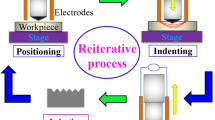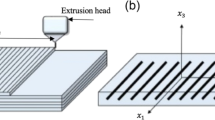Abstract
This work focused on ascertaining the effect of pile-up during indentation of thin films on substrates. Conventional understanding has postulated that differences in contact area resulting from pile-up or sink-in significantly alter the extraction of material properties. In this work, the specific case of pile-up with compliant, plastically deforming films on stiff, nonplastically deforming substrates was studied. Several literature methods to assess pile-up were leveraged, and a new technique was developed and validated to quantify projected pile-up. Indentation testing was performed on gold films of multiple thicknesses on several ceramic-based substrates. The results indicated that the degree of pile-up was solely a function of indent depth into the film. Pile-up was not influenced by film thickness or substrate elastic modulus. In other words, the pile-up development was insensitive to the presence of the substrate and how it contributes to the composite’s elastic properties. In such case, if the elastic response of the film/substrate composite was independent of the degree of pile-up, then elastic data acquired from unloading did not require a contact area correction. The findings are confirmed using the Zhou–Prorok model for extracting film elastic properties for both gold and platinum films.











Similar content being viewed by others
References
W.C. Oliver and G.M. Pharr: An improved technique for determining hardness and elastic modulus using load and displacement sensing indentation experiments. J. Mater. Res. 7, 1564 (1992).
W.C. Oliver and G.M. Pharr: Measurement of hardness and elastic modulus by instrumented indentation: Advances in understanding and refinements to methodology. J. Mater. Res. 19, 3 (2004).
X. Li and B. Bhushan: A review of nanoindentation continuous stiffness measurement technique and its applications. Mater. Charact. 48, 11 (2002).
M.F. Doerner and W.D. Nix: A method for interpreting the data from depth-sensing indentation instruments. J. Mater. Res. 1, 601 (1986).
R.B. King: Elastic analysis of some punch problems for a layered medium. Int. J. Solids Struct. 23, 1657 (1987).
R. Saha and W.D. Nix: Effects of the substrate on the determination of thin film mechanical properties by nanoindentation. Acta Mater. 50, 23 (2002).
H. Gao, C-H. Chiu, and J. Lee: Elastic contact versus indentation modeling of multi-layered materials. Int. J. Solids Struct. 29, 2471 (1992).
J. Hay and B. Crawford: Measuring substrate-independent modulus of thin films. J. Mater. Res. 26, 727 (2011).
G.M. Pharr: Measurement of mechanical properties by ultra-low load indentation. Mater. Sci. Eng., A 253, 151 (1998).
B. Zhou and B. Prorok: A discontinuous elastic interface transfer model of thin film nanoindentation. Exp. Mech. 50, 793 (2010).
B. Zhou and B.C. Prorok: A new paradigm in thin film nanoindentation. J. Mater. Res. 25, 1671–1678 (2010).
W.D. Nix: Elastic and plastic properties of thin films on substrates: Nanoindentation techniques. Mater. Sci. Eng., A 234–236, 37–44 (1997).
X. Chen and J.J. Vlassak: Numerical study of the measurement of thin film mechanical properties by means of nanoindentation. J. Mater. Res. 16, 2974–2982 (2001).
K.W. McElhaney, J.J. Vlassak, and W.D. Nix: Determination of indenter tip geometry and indentation contact area for depth-sensing indentation experiments. J. Mater. Res. 13, 1300–1306 (1998).
A. Bolshakov and G.M. Pharr: Influences of pileup on the measurement of mechanical properties by load and depth sensing indentation techniques. J. Mater. Res. 13, 1049–1058 (1998).
B. Taljat and G.M. Pharr: Development of pile-up during spherical indentation of elastic–plastic solids. Int. J. Solids Struct. 41, 3891–3904 (2004).
W.D. Callister, Jr. and D.G. Rethwisch: Fundamentals of Materials Science and Engineering: An Integrated Approach, Vol. 3. (John Wiley & Sons, Hoboken, NJ, 2008).
P. Boch, J.C. Glandus, J. Jarrige, J.P. Lecompte, and J. Mexmain: Sintering, oxidation and mechanical properties of hot pressed aluminum nitride. Ceram. Int. 8, 34–40 (1982).
R.R. Gupta and M.D. Lechner: Landolt-Bonstein-Group III Condensed Matter (Springer, New York, 2005).
C. Liang and B.C. Prorok: Measuring the thin film elastic modulus with a magnetostrictive sensor. J. Micromech. Microeng. 17, 709 (2007).
L. Wang, C. Liang, and B.C. Prorok: A comparison of testing methods in assessing the elastic properties of sputter-deposited gold films. Thin Solid Films 515, 7911 (2007).
L. Wang and B.C. Prorok: Characterization of the strain rate dependent behavior of nanocrystalline gold films. J. Mater. Res. 23, 55 (2008).
L. Wang and B.C. Prorok: Inverstigation of the influence of grain size, texture, and orientation on the mechanical behavior of freestanding polycrystalline gold films. MRS Proc. 924, Z03–13 (2006).
C.A. Schneider, W.S. Rasband, and K.W. Eliceiri: NIH image to ImageJ: 25 years of image analysis. Nat. Methods 9, 671 (2012).
H.D. Espinosa and B.C. Prorok: Size effects on the mechanical behavior of gold thin films. J. Mater. Sci. 38, 4125 (2003).
H.D. Espinosa, B.C. Prorok, and M. Fischer: A methodology for determining mechanical properties of freestanding thin films and MEMS materials. J. Mech. Phys. Solids 51, 47 (2003).
H.D. Espinosa, B.C. Prorok, and B. Peng: Plasticity size effects in free-standing submicron polycrystalline FCC films subjected to pure tension. J. Mech. Phys. Solids 52, 667 (2004).
B.C. Prorok and H.D. Espinosa: Effects of nanometer-thick passivation layers on the mechanical response of thin gold films. J. Nanosci. Nanotechnol. 2, 427 (2002).
K. Kese and Z.C. Li: Semi-ellipse method for accounting for the pile-up contact area during nanoindentation with the Berkovich indenter. Scr. Mater. 55, 699 (2006).
K.O. Kese, Z.C. Li, and B. Bergman: Method to account for true contact area in soda-lime glass during nanoindentation with the Berkovich tip. Mater. Sci. Eng., A 404, 1 (2005).
T.Y. Tsui, W.C. Oliver, and G.M. Pharr: Influences of stress on the measurement of mechanical properties using nanoindentation: Part I. Experimental studies in an aluminum alloy. J. Mater. Res. 11, 752 (1996).
A. Bolshakov, W.C. Oliver, and G.M. Pharr: Influences of stress on the measurement of mechanical properties using nanoindentation: Part II. Finite element simulations. J. Mater. Res. 11, 760 (1996).
Author information
Authors and Affiliations
Corresponding author
Rights and permissions
About this article
Cite this article
Sullivan, M., Prorok, B.C. Evaluating indent pile-up with metallic films on ceramic-like substrates. Journal of Materials Research 30, 2046–2054 (2015). https://doi.org/10.1557/jmr.2015.167
Received:
Accepted:
Published:
Issue Date:
DOI: https://doi.org/10.1557/jmr.2015.167




